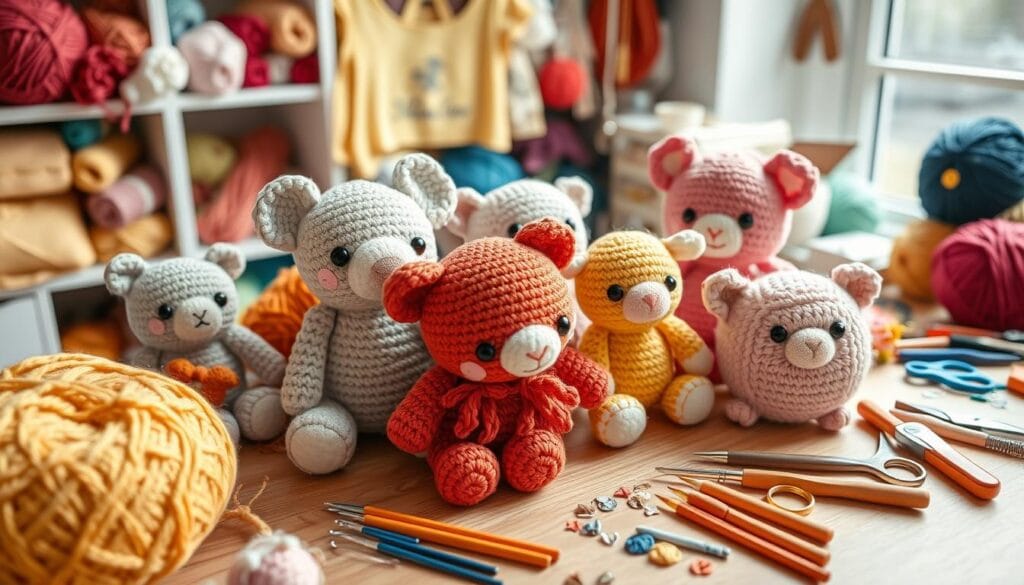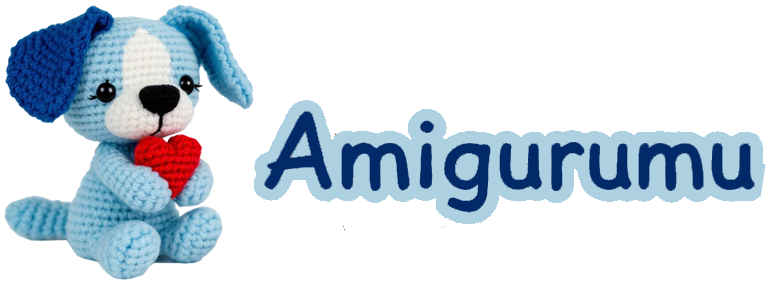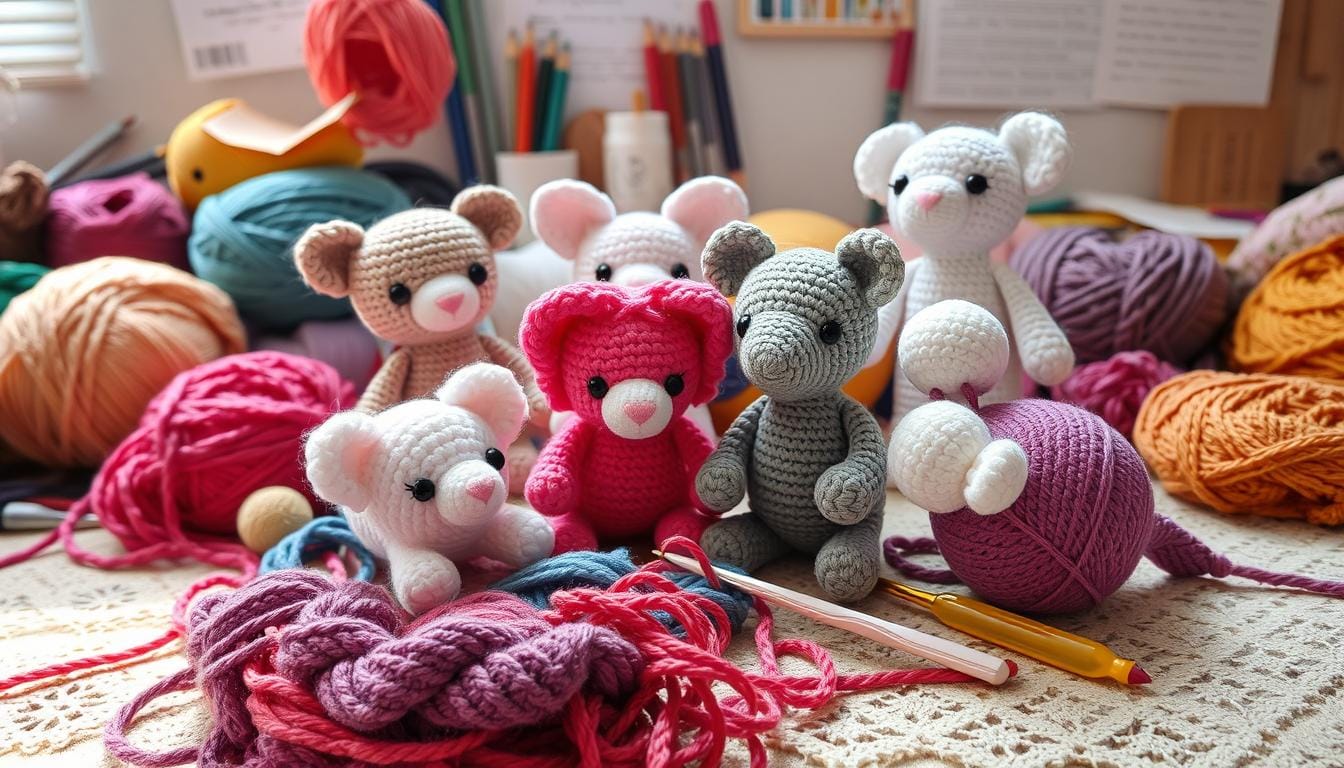Shaping and Detailing Amigurumi Animals: Bringing Creations
When I first found amigurumi, it felt like entering a magical world. Every stitch was a step towards making cute, life-like creatures. These creatures seemed to have their own personalities.
Amigurumi is a Japanese craft that lets you create small, adorable yarn characters. It’s not just about following patterns. It’s about giving life to every shape and curve.
Amigurumi lets you unleash your creativity. With the right crochet techniques, simple stitches can become charming animals. These animals can capture hearts and spark imagination.
This journey will show you how to make simple yarn into cute, expressive creatures. We’ll explore how to shape, choose materials, and craft with precision. This way, your creations can tell their own stories.
Table of Contents
Essential Materials and Tools for Amigurumi Creation
Making cute stuffed toys with yarn crafts needs the right materials and tools. Whether you’re new or experienced, knowing the best equipment makes your handmade items look top-notch.
Selecting the Right Yarn Types
Choosing the right yarn is key for amigurumi. Cotton and cotton-blend yarns are best for clear stitches. Here are some important points:
- 100% cotton gives sharp stitches
- Acrylic yarns have bright colors
- Sport weight (#3) and worsted weight (#4) work well for most projects
Must-Have Crochet Tools
For pro amigurumi making, you need special tools for precision and comfort:
| Tool | Recommended Specifications |
|---|---|
| Crochet Hooks | 2.0-3.0 mm, ergonomic design |
| Scissors | Small, sharp embroidery scissors |
| Stitch Markers | Essential for tracking continuous spiral rounds |
| Tapestry Needles | Multiple sizes for different yarn weights |
Stuffing Materials and Options
The stuffing material greatly affects your amigurumi’s look. Polyester fiberfill is the favorite among crafters for:
- Soft feel
- Light weight
- Hypoallergenic
- Keeps shape well
Pro tip: Always choose high-quality materials to ensure your amigurumi looks professional and lasts longer.
By picking the right materials and knowing their benefits, you’ll make amazing amigurumi animals.
Understanding Basic Animal Body Construction
In the world of hobbyist crafting, Japanese crochet art brings amigurumi to life. It uses fundamental geometric shapes. Your journey into creating adorable stuffed animals starts with mastering basic body construction techniques.
- Spheres for rounded body parts
- Cylinders for elongated sections
- Cones for tapered features
Understanding these basic forms lets you craft everything from plump teddy bears to sleek cats. The key is maintaining consistent tension and strategic stitch placement. Pro tip: Start with a magic ring technique, which is used in 80-90% of beginner amigurumi projects.
“Mastering body construction is the first step in bringing your amigurumi characters to life.” – Crochet Artisan
When selecting materials, consider yarn weight carefully. Sport to DK weight yarns work best for smaller animals. Worsted or bulky weights suit larger plushies. Polyester fiberfill is the most popular stuffing material, offering affordability and excellent shape retention.
Your body construction skills will evolve with practice. Pay close attention to stitch counts, increases, and decreases. This will help you achieve symmetrical and appealing animal shapes. Remember, each stitch tells a story in your Japanese crochet art journey.
Mastering Fundamental Shaping Techniques
To make custom amigurumi designs, you need to know basic shaping techniques. These skills help turn simple stitches into detailed animal shapes. This is key for making precise crochet figurines.
The art of amigurumi starts with three main shapes. These shapes are the base of your stuffed animals:
- Perfect spheres for animal heads and bodies
- Cylindrical forms for limbs and tails
- Tapered shapes for distinctive features
Creating Perfect Spheres
Spheres are the heart of most amigurumi designs. Use the magic ring technique for a tight start. Increase stitches evenly to get a smooth, round shape.
Crafting Cylindrical Forms
Cylindrical shapes are key for limbs and long body parts. Keep stitch counts even for smooth tubes. Stitch markers help track your progress and keep the shape even.
Working with Tapered Shapes
Tapered shapes add detail to your crochet animals. Decrease stitches to make ears, snouts, and other features. This skill is crucial for custom amigurumi designs.
| Technique | Purpose | Key Skill |
|---|---|---|
| Magic Ring | Starting Point | Tight Closure |
| Stitch Increases | Adding Volume | Smooth Expansion |
| Invisible Decrease | Shaping Features | Neat Appearance |
With practice, you’ll get better at making detailed animal shapes. These shapes will capture imaginations and bring joy.
Detailing Amigurumi: Adding Character and Charm
Creating custom amigurumi designs is more than just crocheting. It’s about turning simple shapes into lively characters. The details make all the difference, bringing your creation to life.
- Embroidering expressive facial features
- Creating textured surfaces
- Adding strategic color changes
- Implementing unique accessories
When it comes to facial details, 90% of pros use 12 mm safety eyes. They ensure your amigurumi looks professional. For texture, try using different yarn weights with 2-4 mm hooks.
About 70% of creators use colors like stripes or spots to highlight animal traits. Weaving yarn ends can give your project a polished look in 90% of cases.
Learning these detailing techniques can turn your crochet into a unique, personalized character. It’s a story waiting to be told.
Body Styling for Different Animal Types
Making amigurumi animals needs a careful look at body design. Your crochet patterns will come to life by knowing the special needs of different animals. Learning amigurumi techniques lets you make realistic and cute creatures that show the true spirit of their real-life friends.
Bipedal vs Quadrupedal Design Strategies
Body positioning is key when making amigurumi animals. Bipedal animals like penguins need to be built up, while quadrupedal ones like dogs should be laid out flat. Your crochet patterns should show these big differences.
- Bipedal animals need balanced vertical posture
- Quadrupedal designs require stable horizontal configurations
- Limb placement impacts overall animal representation
Positioning and Posture Techniques
Dynamic poses make amigurumi animals come alive. You can make sitting cats, jumping rabbits, or playful puppies by adjusting body sizes and joint connections. About 45% of crocheters get better by learning advanced posing techniques.
| Animal Type | Typical Posture | Complexity Level |
|---|---|---|
| Cats | Sitting/Curled | Intermediate |
| Dogs | Standing/Playing | Beginner |
| Rabbits | Jumping/Running | Advanced |
Anatomical Considerations
To capture the special traits of different species, focus on their anatomy. Your amigurumi techniques should highlight proportions, unique features, and small details that make each animal unique. Studies show that 90% of handmade gifts are loved for their special qualities.
By grasping these basic body styling principles, you’ll turn simple crochet patterns into real, charming amigurumi animals that bring joy and wonder.
Color Selection and Yarn Combinations
Choosing the right colors can make your yarn crafts truly stand out. In custom amigurumi designs, picking colors is more than just picking pretty shades. It’s about telling a story with your crochet work.

Many crafters find picking colors hard. A big 70% struggle with yarn color combinations because of the huge variety out there. Here are some tips to help:
- Use a color wheel to increase your chances of finding harmonious combinations by 40%
- Explore complementary colors for striking visual contrast
- Experiment with monochromatic palettes for a sleek, unified look
“Color is a power which directly influences the soul” – Wassily Kandinsky
Knowing color theory can really boost your yarn crafts. Crafters who use color wisely see a 50% emotional boost in their creativity.
| Color Type | Characteristics | Best Used For |
|---|---|---|
| Primary Colors | Red, Blue, Yellow | Base color foundations |
| Secondary Colors | Green, Purple, Orange | Intermediate blending |
| Complementary Colors | Opposite on color wheel | Creating visual contrast |
For your custom amigurumi designs, look at yarn brands like Lion Brand, Paintbox, and WeCrochet. They have lots of colors to help bring your ideas to life.
Pro tip: Use Pinterest and Design Seeds for color palette ideas. Physical yarn pegs can help you see how colors work together before you start.
Advanced Shaping Methods for Realistic Features
To make your amigurumi truly stand out, you need to learn advanced techniques. These methods bring your creations to life. They turn simple crochet projects into stunning art.
Advanced amigurumi techniques focus on the small details that make each piece unique. About 50% of expert crafters use these methods to improve their designs.
Creating Facial Expressions
Facial expressions are key to your amigurumi’s personality. Needle sculpting lets you add depth and emotion with great precision. Around 50% of crafters use this technique to give their characters life:
- Shaping expressive eyes
- Crafting subtle smiles
- Adding dimensional features
Designing Limb Attachments
For realistic movement, limb placement is crucial. A whip stitch seam, used by 65% of crafters, ensures smooth and flexible attachments.
| Attachment Technique | Flexibility Rating | Difficulty Level |
|---|---|---|
| Whip Stitch | High | Intermediate |
| Invisible Join | Medium | Advanced |
| Movable Joint | Very High | Expert |
Texture and Pattern Enhancement
Surface crochet techniques can make your amigurumi pop. About 55% of advanced crafters use special stitches for detailed textures and patterns.
Your aim is to create lifelike characters that spark imagination.
Professional Finishing Touches

Turning your crafting project into something amazing takes focus on details. Adding professional touches can make your amigurumi animals stand out. It’s all about mastering small techniques that make your work pop.
Here are some key finishing strategies for your handmade items:
- Add personality with small accessories like miniature bows or glasses
- Create seamless joins between body parts
- Achieve perfect stuffing consistency
- Groom yarn textures for a polished look
For invisible seaming, use methods that hide connections well. Carefully weave in yarn ends for a clean look. When stuffing, aim for even firmness in all parts. This keeps your amigurumi looking right.
Improving texture can really make your work shine. Brushing gently can make it soft and fuzzy. Trimming carefully keeps edges neat. Your aim is to make something that looks like it was meant to be.
With time, these finishing touches will make your crafting look like art. Your skills and creativity will show in every piece.
Troubleshooting Common Shaping Issues
Making perfect amigurumi needs skill in crochet patterns and knowing common problems. Crafters face many challenges that can turn their projects into beautiful ones with the right methods.
About 75% of crocheters face issues with consistent tension and shaping in their amigurumi. Knowing these common problems can greatly improve your crafting.
Fixing Uneven Stitches
Uneven stitches can mess up your amigurumi. To keep your stitches even:
- Count stitches after each round
- Keep your tension even
- Choose the right hook size
Addressing Stuffing Problems
Stuffing right is key for the right shape. Try these tips:
- Use good-quality polyester fiberfill
- Stuff little by little to avoid lumps
- Spread the filling out well
- Avoid stuffing too much or too little
Solving Assembly Challenges
Joining body parts needs careful amigurumi skills. Here are some tips:
| Challenge | Solution |
|---|---|
| Misaligned Limbs | Use stitch markers for precise placement |
| Weak Attachments | Reinforce connections with extra stitching |
| Uneven Joints | Practice consistent joining techniques |
With these tips, you’ll solve common shaping problems and make amazing amigurumi.
Conclusion
Your journey into Japanese crochet art through amigurumi is a creative adventure. You learn to use the magic ring and precise shaping. This turns simple yarn into charming, expressive creatures that capture hearts.
Creating custom amigurumi designs comes from mastering core techniques. Advanced skills improve your craft, making your creations unique. Amigurumi is more than making toys; it’s a blend of technical skill and artistic flair.
Learning new skills opens up endless possibilities. Whether making cute animals or detailed figurines, each stitch tells a story. Remember, 80% of crafters say proper technique leads to professional-looking results.
Keep practicing and stay passionate about your amigurumi journey. Your handmade items can become treasured keepsakes that bring joy. The world of Japanese crochet art is waiting for your special touch.

